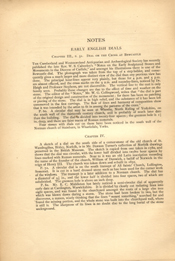NOTES
EARLY ENGLISH DIALS
CHAPTER III., P. 51.
DIAL ON THE CROSS AT BEWCASTLE.
THE Cumberland and Westmoreland Antiquarian and Archæological Society has recently published the late Rev. W. S. Calverley's "Notes on the Early Sculptured Stones and Monuments in the Diocese of Carlisle," and amongst his illustrations there is one of the Bewcastle dial. The photograph was taken from the top of a step-ladder, and consequently gives a much larger and more distinct view of the dial than any previous view has done. The principal hour-lines appear very plainly, but those for 4 p.m. and 5 p.m. are almost effaced, and the cross marks on the 9 a.m. and noonday-lines, noticed by Dr. Haigh and Professor Stephens, are not discernible. The vertical line to the east is only faintly seen. Probably these changes are due to the effect of time and weather on the stone. The editor of the "Notes," Mr. W. G. Collingwood, writes that "the dial is part of the original design and construction of the monument; for there has been no patching or piecing of the stone. The dial is in high relief, and the substance of it has been left unremoved in the first carvings. The flow of lines and harmony of composition show that it was intended by the artist to fit in among the patterns of the cross."
P. 60. A circular dial may be seen at Whenby, North Riding of Yorkshire, on the south wall of the thirteenth century church, and is probably of much later date than the building. The dial is divided into twenty-four spaces; the gnomon hole is 1 ½ in. deep, and there are faint traces of Roman numerals.
Four stones with dials cut on them have been noticed in the south wall of the Norman church of Stainburn, in Wharfedale, Yorks.
A sketch of a dial on the south side of a corner-stone of the old church of St. Wandregilius, Bixley, Norfolk, is in Mr. Dawson Turner's collection of Norfolk drawings preserved in the British Museum. The sketch is copied from one taken in 1780, and shows that the dial was circular, with the lower half divided into twelve hour spaces by lines marked with Roman numerals. Near to it was an old Latin inscription recording the name of the founder of the church, William of Dunwich, a bailiff of Norwich in the reign of Henry III. The church was taken down and rebuilt in 1850.
P. 72. A circular dial is on the south transept of All Saints' Church, Lullington, Somerset. It is cut in a hard dressed stone such as has been used for the corner work of the windows. The transept is a later addition to a Norman church. The dial has a diameter of 9 1/4 in., and the lower half is divided into four spaces, two of which are subdivided. The gnomon hole is above an inch deep.
P. 80. Mr. E. C. Middleton has lately noticed a semi-circular dial of apparently early date at Cardington, Warwickshire. It is divided by clearly cut radiating lines into eight spaces, and was found in the churchyard amongst the roots of a large elm tree which was blown down during a storm. The stone had been broken in two, but the discoverer, a mason, wisely thinking that the lines "meant something," searched for and found the missing portion, and the whole stone was built into the churchyard wall, where it still is. The sharpness of its lines is no doubt due to the long burial of the stone underground.
